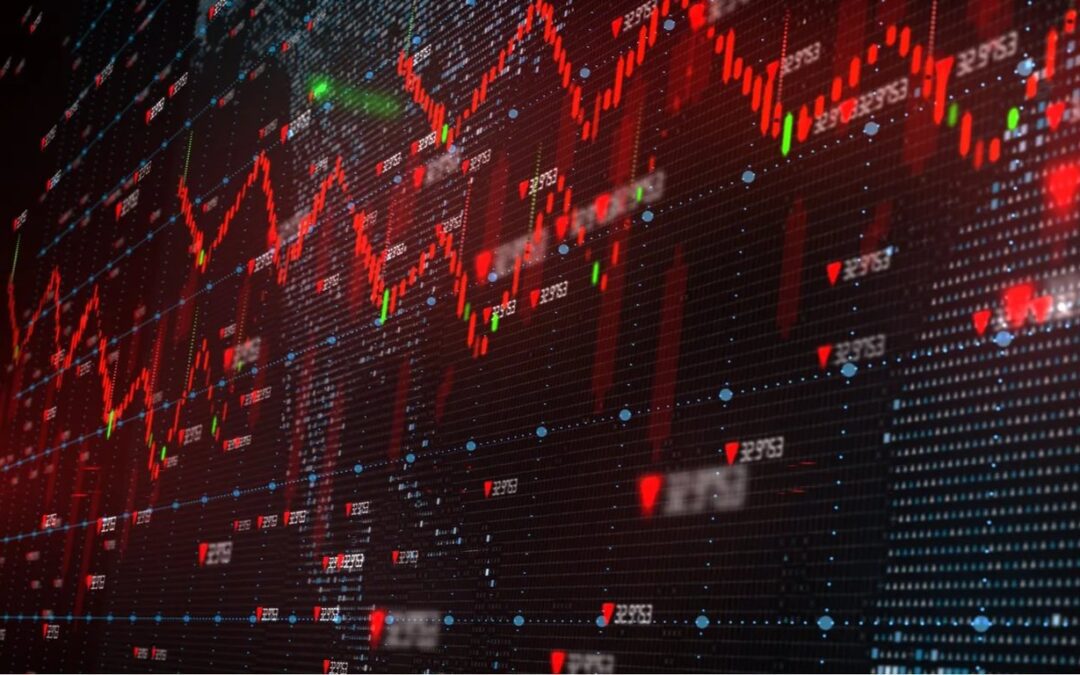
by | Jun 22, 2025 | Business
The crypto market plunged as the U.S. and Israel launched airstrikes on Iran’s nuclear sites, sending Bitcoin below $100K and triggering over $1B in liquidations. Rising geopolitical tensions and inflation fears spark panic selling across digital assets.
The cryptocurrency market experienced a dramatic downturn over the weekend as geopolitical tensions erupted following the U.S. and Israel’s coordinated airstrikes on Iran’s nuclear facilities.
Bitcoin plummeted below the critical $100,000 threshold, and major altcoins followed suit, triggering mass liquidations and sparking fear across risk markets.
Tensions Ignite: U.S. Bombs Iranian Nuclear Sites
On Sunday, June 22, the global geopolitical landscape was rocked after the United States, under orders from former President Donald Trump, joined Israel in launching targeted airstrikes on three Iranian nuclear sites, Fordow, Natanz, and Isfahan.
Trump declared the mission a “complete and total success,” aiming to dismantle Iran’s nuclear enrichment infrastructure. Iran, meanwhile, vowed swift retaliation, deepening fears of a broader Middle East conflict.
According to the New York Times, this military action dramatically escalates tensions in a region already teetering on the brink, prompting immediate shockwaves across financial markets, especially crypto.
Crypto Market Turns Red: Bitcoin Breaks Below $100K
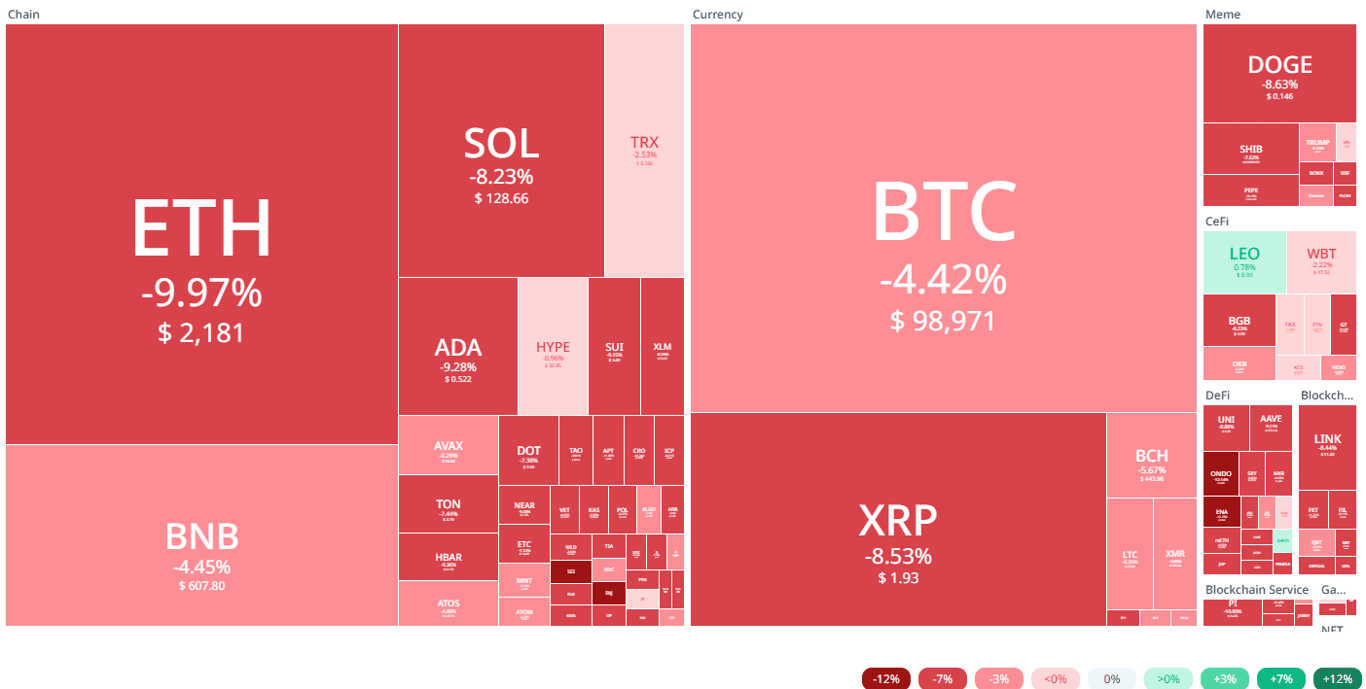
The crypto market reacted instantly to the news. Within hours of the airstrikes, Bitcoin’s price crashed by over 4%, falling from a stable $103,000 to as low as $98,971. This marks the first time in over 40 days that BTC traded below the $100K psychological support level.
Key Crypto Price Drops:
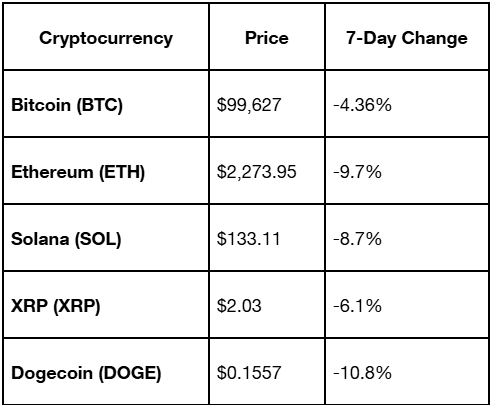
Virtuals Protocol, Celestia (TIA), Aptos (APT), and AB were among the hardest-hit altcoins, all losing over 9% in the past 24 hours.
Massive Liquidations and Market Fear
CoinGlass data revealed that total liquidations surged by 38% to over $682 million in a 24-hour span, with $1 billion in total crypto value wiped out across exchanges. Most of the liquidations targeted high-leverage positions in Bitcoin, Ethereum, and Solana.
The fear was palpable. Trading volume in Bitcoin spiked over 33%, indicating that panic selling—not normal trading, was driving the market activity. Altcoin segments such as AI tokens, including FET and VIRTUAL, lost nearly 10%, while Cardano (ADA) approached a three-month low.
Why Did Crypto Crash? Two Core Reasons
1. Risk-Off Sentiment Amid Geopolitical Uncertainty
Historically, major geopolitical events trigger a “risk-off” sentiment in financial markets. Investors flee from volatile, riskier assets—like crypto and equities—and pile into safe-haven assets such as gold, the U.S. dollar, and government bonds.
Hanain Malik of Tellimer told Bloomberg:
“Short-term, markets such as crude oil, stocks, and crypto will pivot on whether Iran retaliates and widens the war in a way that impacts oil supply versus backing down and offering concessions on its nuclear program.”
2. Inflation and Fed Policy Concerns
Oil prices surged following the strikes, with Brent crude and WTI up over 32% from yearly lows. Shipping costs are also climbing, signaling that U.S. consumer inflation could spike again. This would pressure the Federal Reserve to maintain higher interest rates longer than previously expected.
Last week, the Fed kept rates steady at 4.25%–4.50% and hinted at two rate cuts in 2025. But surging oil and inflation fears could derail those plans, which is bearish for crypto, as digital assets tend to perform better in low-rate environments.
Market Outlook: What’s Next?
With Bitcoin hovering just above $99,000 and Ethereum sliding below $2,300, traders are bracing for more volatility in the coming days. Analysts warn that if Iran retaliates, Bitcoin could dip to $95K or even lower.
The next 48 hours are critical. Any signal of an Iranian counterstrike or prolonged conflict could intensify the sell-off. On the flip side, a diplomatic de-escalation could provide temporary relief and possibly trigger a market rebound.
Conclusion
The U.S.-Iran conflict has once again highlighted the vulnerability of crypto markets to macro and geopolitical shocks. As tensions escalate, traders and investors are adopting a cautious stance.
With more than $1 billion wiped out in a day and sentiment turning defensive, the crypto market enters a critical phase.
All eyes are now on Tehran and Washington. The outcome of this standoff may determine whether Bitcoin finds a new floor—or continues its descent below five-digit territory.
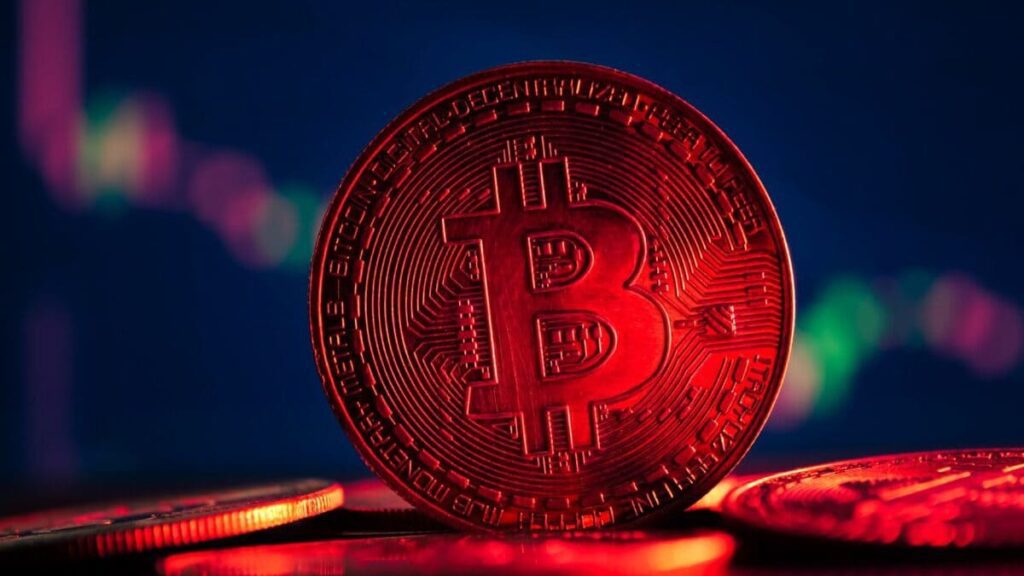
by | Jun 22, 2025 | Business
Bitcoin’s current rally is drawing eerie comparisons to 2017, but Real Vision CEO Raoul Pal believes this crypto cycle could stretch into 2026. Meanwhile, rising geopolitical tensions in the Middle East and fears over oil disruptions are sending shockwaves through global markets and triggering high volatility across BTC, ETH, and XRP.
The crypto market is undergoing a storm of macroeconomic momentum and geopolitical shockwaves, prompting analysts to draw parallels with previous bull cycles, most notably the landmark rally of 2017.
Raoul Pal, CEO of Real Vision and former Goldman Sachs executive, believes that the current environment shares “spooky” similarities to 2017, yet is also setting the stage for an even longer and more volatile crypto cycle, potentially stretching into 2026.
Simultaneously, escalating Middle East tensions, fueled by a sudden U.S.-Israel-led strike on Iranian nuclear facilities, have sent shockwaves through global markets.
The aftermath has triggered dramatic price swings in Bitcoin, Ethereum, XRP, and broader risk assets, while threatening global oil supply and further inflaming inflation fears.
Bitcoin’s Trajectory Echoes 2017, But the Cycle May Be Extended
According to Pal, Bitcoin’s current market behavior eerily mimics the trend seen in 2017, when BTC climbed steadily throughout the year before its historic December breakout. In 2017, Bitcoin soared from $1,044 in January to $14,156 by December, a staggering 1,255% gain.
However, this time may be different. Pal emphasizes that macroeconomic indicators, especially his “business cycle score”, signal we’re still early in the broader economic upcycle, and that could extend the crypto bull run for years.
“It’s spookily similar to 2017,” Pal said. “But this cycle could go longer, possibly into Q2 2026, especially with the weakening U.S. dollar acting as a tailwind.”

Indeed, since the start of 2025, the U.S. Dollar Index (DXY) has dropped nearly 9%, sitting at 98.77, making Bitcoin more attractive as both a speculative asset and a potential hedge against fiat debasement.
Macro Tailwinds and Institutional Adoption Fuel Market Optimism
Pal pointed out that macro forces, especially delayed interest rate adjustments and a stagnating dollar throughout much of 2024, have caused the crypto cycle to shift and potentially expand.
“The whole cycle got shifted because rates didn’t get adjusted,” he noted. “This looks more like 2020 than 2021, it feels like the earlier stages of a bull market.”
Meanwhile, the Middle East is rapidly emerging as a crypto hub. On a recent trip to the region, Pal met with several Sovereign Wealth Funds across Saudi Arabia, UAE, Bahrain, and Qatar. Their verdict?
“The mandate across the region is clear: AI and blockchain. Governments aren’t just investing in Bitcoin, they’re building entire infrastructures on the blockchain,” Pal reported.
This growing institutional interest suggests that long-term capital is entering the space, potentially cushioning crypto against the typical boom-bust patterns.
Chaos in the Middle East: War and Oil Choke Points Shake Crypto
However, just as macro tailwinds offered optimism, geopolitical tensions have rattled investor confidence.
On Saturday, the U.S., alongside Israeli forces, launched coordinated strikes on Iranian nuclear facilities in Fordow, Natanz, and Isfahan. In retaliation, Iran fired 27 missiles into Israeli territory, hitting targets in Tel Aviv, Haifa, and the Golan Heights.
The chaos reverberated across markets:
- Bitcoin crashed to $100,945 within minutes of the announcement, shedding over $40 billion in market cap.
- It later rebounded slightly to $102,350, but warning signs remain.
- Ethereum (ETH) and XRP also suffered, falling to their lowest levels in weeks.
Technical indicators aren’t reassuring either. Bitcoin is testing the $102K level repeatedly. A fresh “death cross” (when the 50-day SMA falls below the 200-day SMA) and tightening Bollinger Bands point to potential further volatility.
Strait of Hormuz in Focus: A Looming Economic Catastrophe?
Further compounding the market turmoil is Iran’s potential move to block the Strait of Hormuz, a strategic waterway handling around 20% of global oil supply. According to reports, over 50 large oil tankers scrambled to flee the region following the U.S. strikes.
Market analysts, including JPMorgan, have warned that oil prices could surge to $130 per barrel, pushing U.S. inflation to 5%—levels not seen since early 2023. Such a spike could force the Federal Reserve to reconsider future rate cuts, tightening financial conditions and possibly triggering broader risk-off sentiment.
Crypto as a Safe Haven—or Risk Asset?
These events reinforce a growing debate: Is Bitcoin a safe haven, or merely another speculative asset?
In times of economic uncertainty, Bitcoin has historically attracted capital as a non-sovereign store of value. However, during acute crises, especially those with global military implications, it often reacts like a high-risk tech stock.
Still, some analysts believe these conditions set the stage for another breakout. Historically, long periods of consolidation, like the one Bitcoin is currently experiencing—have preceded parabolic moves.
Conclusion: A Battle Between Macro Optimism and Geopolitical Fear
The crypto market is currently walking a tightrope. On one side are powerful macro tailwinds, institutional adoption, and weakening fiat currencies, elements that mirror the bullish backdrop of 2017 and 2020.
On the other side lies geopolitical instability that threatens to short-circuit global markets.
With sovereign funds betting big on blockchain, and the global economy just beginning to recover, the longer-term outlook for crypto remains bullish.
But in the short term, expect turbulence as markets digest war headlines, oil price shocks, and uncertainty in the Strait of Hormuz.
As Raoul Pal put it, “The cycle’s not over—it might just be getting started.”
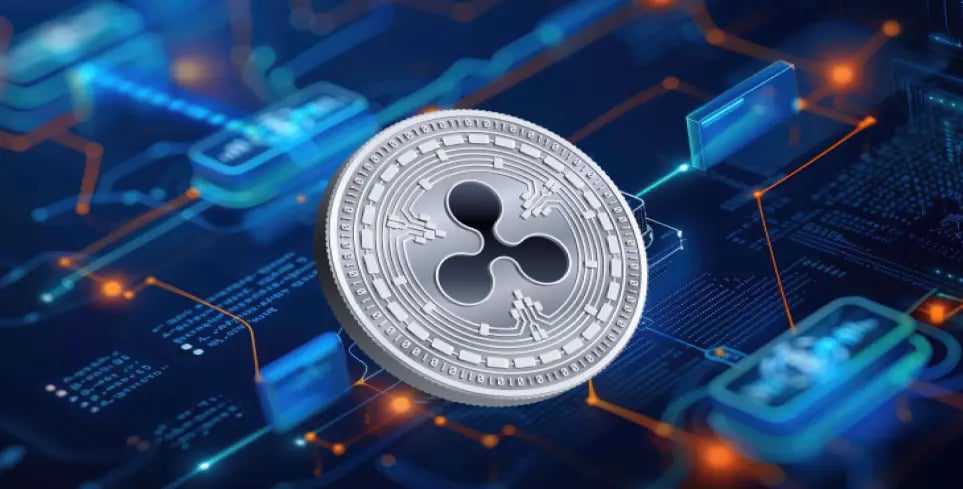
by | Jun 22, 2025 | Business
Ripple’s XRP faces renewed volatility amid rumors of U.S. government seizure and legal uncertainty with the SEC, while stablecoin RLUSD rapidly approaches a $500M market cap. Could Ripple’s bold stablecoin push shape XRP’s future?
The crypto market was rattled over the weekend by fresh speculation involving Ripple and its flagship digital asset, XRP. On June 22, XRP slid another 8.13%, closing at $1.9378.
The drop came as rumors circulated that the US government could seize Ripple’s escrowed XRP holdings to build national crypto reserves, a theory floated by crypto analyst John Squire.
However, legal expert and pro-crypto attorney Bill Morgan swiftly debunked the claim, stating, “No, it won’t.” Despite this, the narrative gained just enough traction to spook investors already on edge.
XRP Legal Drama Continues: The Judge Torres Factor
XRP’s downward trend isn’t just about baseless government seizure theories. The ongoing lawsuit between Ripple and the U.S. Securities and Exchange Commission (SEC) remains the primary cloud over the token.
After a prior procedural rejection, Ripple and the SEC jointly filed a renewed motion on June 12, asking Judge Analisa Torres for an indicative ruling that could finally lift the ban on XRP sales to institutional investors and reduce the $125 million penalty.
Since Judge Torres rejected the initial motion quickly—within seven days—investors are now growing uneasy due to the silence following the second motion.
Why does this matter? A favorable ruling could end the multi-year lawsuit and open the door for XRP spot ETF approvals, unlocking a potentially massive price surge. Conversely, a rejection could trigger exchange delistings, ETF rejections, and further price erosion.
Ripple’s Strategic Countermove: RLUSD’s Meteoric Rise
Amid the courtroom drama, Ripple is making bold moves elsewhere. Most notably, Ripple has minted 13 million RLUSD tokens, pushing the total supply of its stablecoin close to $500 million.
According to Etherscan and data from CoinGecko, this brings RLUSD’s market cap to approximately $428.7 million, putting it in the sights of industry giants like Tether (USDT) and Circle (USDC).
RLUSD’s growth has been strategic, fast, and targeted, with recent token batches flowing into wallets linked to major liquidity pools.
Analysts believe these tokens are headed for listings on centralized exchanges (CEXs) and decentralized finance (DeFi) platforms, further boosting RLUSD’s real-world utility.
The Big Picture: RLUSD, XRP, and Ripple’s Multi-Chain Vision
Despite being a Ripple product, RLUSD is currently issued on Ethereum rather than the XRP Ledger (XRPL).
However, integration with XRPL and other blockchains is reportedly in the works, aligning with Ripple’s multi-chain strategy to expand its ecosystem’s influence.
Ripple’s partnerships are also strengthening RLUSD’s utility. A notable alliance with AlchemyPay now enables RLUSD access via major fiat payment networks like Visa, Mastercard, and Apple Pay.
Regulatory wins, including licensing in Dubai, suggest RLUSD is poised for broader global adoption.
This all feeds into speculation that RLUSD may indirectly support XRP’s valuation by anchoring Ripple’s ecosystem in regulated, liquid, and widely adopted assets.
XRP Price Outlook: A Game of Legal Dominoes
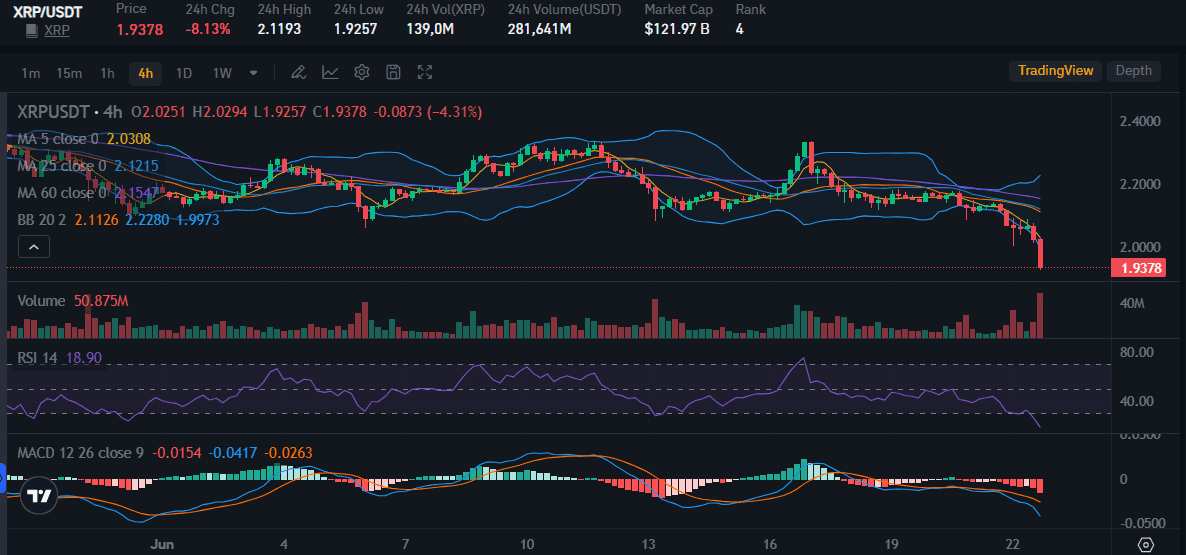
XRP currently trades under both its 50-day and 200-day Exponential Moving Averages (EMA)—a technical red flag. At the time of writing, the 14-hours RSI sits at 18.90, indicating that XRP may still have room to fall before entering “oversold” territory below RSI 20.
If Judge Torres rules in Ripple’s favor:
- XRP could break above $2.2, reclaim $2.6553, and aim for 2025’s high of $3.3999.
- Spot ETF approval could follow, potentially driving XRP to record highs above $3.5.
But if the motion is rejected or delayed:
- XRP could fall below $2.
-
The next support lies at $1.9299, and a drop toward $1.5 is not off the table.
Macro Factors: Beyond the Courtroom
XRP’s trajectory is also tied to broader market variables:
- Global conflicts like Iran-Israel tensions.
-
US tariffs and the impact on crypto-friendly trade policies.
-
Federal Reserve decisions on inflation and interest rates.
-
Political dynamics, especially if former President Trump’s pro-crypto agenda gains traction.
These variables all converge to create a highly volatile environment for XRP investors.
RLUSD: The Trojan Horse for Institutional Adoption?
Institutional interest may spike as Ripple’s stablecoin nears the $500M threshold. According to market watchers, this level is more than symbolic—it represents trust, maturity, and reliability for enterprise players.
Further bolstering confidence is RLUSD’s wallet distribution. No single wallet holds an overwhelming supply, indicating healthy decentralization and lowering risk, key considerations for banking and institutional partners, including persistent rumors of Ripple’s collaboration with Bank of America.
Ripple’s Future: Legal Resolutions, Stablecoin Expansion, and Institutional Dreams
Ripple CEO Brad Garlinghouse has made it clear: the legal battles won’t stall innovation.
The company’s ambitious plans for RLUSD, alongside XRP’s potential to process up to 14% of SWIFT’s global transactions within five years, paint a picture of a firm not merely surviving regulatory scrutiny but preparing to thrive beyond it.
Conclusion: A Tale of Two Tokens
The XRP price remains at the mercy of Judge Torres and SEC decisions. But Ripple isn’t standing still.
Through RLUSD, it’s laying the groundwork for a more robust, diversified crypto ecosystem. Whether RLUSD will lift XRP, or simply replace it as Ripple’s flagship asset, remains to be seen.
For now, all eyes remain on the courtroom, but savvy investors are starting to look beyond it.
Stay tuned for further updates on the XRP lawsuit, Ripple ETF developments, and the rise of RLUSD in the fast-moving world of crypto finance by subscribe Bitrue blog.

by | Jun 22, 2025 | Business
Addressing inefficiencies in high-volume Philippine BPO recruitment, MyGlit is an AI platform providing instant resume-to-job matching for candidates and automated screening tools for employers. Purpose-built for BPO roles, it aims to become the go-to portal for faster, more transparent hiring.
MANILA, Philippines – June 22, 2025 – The Philippines’ vital BPO sector, a major employer facing persistent recruitment challenges, is seeing a new approach to talent matching. MyGlit, an AI-powered job platform built specifically for high-volume hiring, has been operational in the Philippines since 2018, focusing on improving efficiency and transparency for both employers and job seekers.
The platform addresses common pain points: candidates often apply “blindly” with low response rates, while recruiters struggle with high application volumes and time-consuming manual screening. MyGlit tackles this by providing instant, AI-driven feedback to candidates on their resume’s fit for each role (“Select,” “Reject,” or “Consider”), helping them target applications more effectively.
For BPO companies like Teleperformance, EXL, and Foundever – already leveraging MyGlit across Metro Manila, Cebu, and regional hubs – the platform offers automated CV-to-job description matching and recruiter performance analytics. This aims to reduce initial review time and improve the accuracy of shortlisting.
“The goal isn’t AI making final decisions, but giving everyone involved – candidates and recruiters – clearer signals and faster feedback loops,” said Akhil Ahluwalia, Founder of MyGlit. “We’re building MyGlit to become the go-to platform for efficient and transparent BPO hiring in the Philippines.”
Key Solutions for the Philippine BPO Market:
Reducing Blind Applications: Shows candidates immediate fit feedback, helping them apply smarter.
Improving Recruiter Efficiency: Automates initial screening based on BPO role requirements (voice, non-voice, shift-based).
Enhancing Transparency: Provides candidates with clearer application status updates.
Built for Scale & Compliance: Designed for high-volume processing while adhering to Philippine data privacy regulations and GDPR.
Positioning for Recognition:
Unlike general job boards, MyGlit is purpose-built for the unique demands of the Philippine BPO recruitment market. Its focus on AI-driven matching, candidate transparency, and recruiter performance analytics positions it as a specialized solution targeting core inefficiencies within the region’s BPO job portal sector.

About MyGlit:
MyGlit is an AI-driven recruitment platform focused on high-volume BPO hiring. By automating initial resume evaluation and providing recruiter analytics, MyGlit supports companies and candidates primarily in the Philippines, while expanding its platform to India, Kenya, Nigeria, and Malaysia. The platform is dedicated to simplifying large-scale recruitment while enhancing the quality of job matches for both employers and job seekers. Learn more at https://www.myglit.com.

by | Jun 20, 2025 | Business
Fathers don’t always ask for much—but behind the strong front are long hours, sore muscles,
and a well of unspoken exhaustion. This Father’s Day, it’s time to turn the tables. Let’s not just
thank Dad. Let’s give him something he rarely asks for but absolutely deserves–rest.
OGAWA Philippines invites you to celebrate the heart of the home with the Meister Massage Chair—a next-generation wellness experience designed for the ultimate relaxation and recovery. It’s more than just a massage chair. It’s your dad’s new personal sanctuary.
Introducing the OGAWA Meister: For the Man Who Does It All
The OGAWA Meister Massage Chair, now officially launched in time for Father’s Day, redefines what it means to give back to Dad. Every inch of this chair was built to support the ones who support us.
From early mornings at work to late nights fixing what’s broken, the Meister is a thank-you in the form of advanced wellness technology—delivered with luxury, comfort, and care.
Next-Level Features Fit for a Hero
Powered by Overseer Technology, the Meister doesn’t just massage—it understands. Its AI Fatigue Measurement and AI Analysis & Program Recommendation systems scan and assess the body, then intelligently recommend the ideal massage for your dad’s current state.
With 25 automatic massage programs to choose from, the Meister makes sure every muscle gets the attention it deserves—whether it’s a deep tissue session after a long day or a gentle unwind before bed.
The Meister also includes:
Voice Control for hands-free convenience
Electrical Muscle Stimulation (EMS) for targeted relief
Over-The-Air Technology for seamless updates and added programs
It’s not just a chair—it’s a wellness companion that evolves with your dad’s needs.
Make His Comfort a Priority—Now More Than Ever
This Father’s Day, the OGAWA Meister is available at a special promo price of only ₱299,000.00 (down from ₱429,000.00 SRP).
And with up to 36 months installment through partner banks, giving Dad the luxury he’s long put off is now easier and more accessible than ever.
Because Dads Deserve More Than Just a Tie
This year don’t settle for a generic gift. Give Dad what he truly deserves: peace, quiet, and a chair that treats him like the king of the house.
Visit any OGAWA showroom nationwide to experience the Meister for yourself or explore the full collection at www.ogawaworld.net.ph.
Let Dad sit back, relax, and feel appreciated—not just on Father’s Day, but every day.
Operating at full capacity with over 30 stores nationwide, OGAWA branches include key locations in One Ayala Makati, Greenhills Mall, Gateway Mall 2, Shangri-La Plaza, SM Megamall, Greenbelt 5, Lucky Chinatown Mall, Robinsons Manila, Ayala Malls Vertis North, Eastwood Mall, Robinsons Magnolia, SM Fairview, SM North EDSA The Block, TriNoma, UP Town Center, Promenade Greenhills, Alabang Town Center, Evia Lifestyle Center, Ayala Malls Manila Bay, SM BF Parañaque, and Newport Mall. For those outside Metro Manila, OGAWA can also be found in SM City Bacoor, Ayala Solenad 3, SM Sta. Rosa in Laguna, SM Seaside City Cebu, SM Lanang Premier in Davao, SM Clark in Pampanga, and SM City Olongapo Central.

by | Jun 20, 2025 | Business
Investors want to open self-managed super funds, to invest in cryptocurrency, and make use of artificial intelligence, found investment platform moomoo Australia and New Zealand in its recent survey of share investors.
But a key finding was that the complexity and cost of opening a SMSF is stopping those interested in opening a fund from doing so.
SMSF complexity holds investors back
Moomoo aims to simplify the complex setup of SMSFs, which is why 24% of interested Australians say they haven’t opened a fund. At the same time, moomoo and its partners offer a transparent range of fees to reassure the 21% of people that cite costs as their reason for not opening a SMSF.
A key third reason interested Australians hold back from opening a SMSF is not knowing what to invest in (24%). So, moomoo is providing a broad range of news and content, including from SMSF experts, to help investors manage their super to deliver for the long term.
“There are clear, legitimate reasons that even those Australians familiar with share investing and interested in opening a self-managed super fund, haven’t done so. We answer these concerns head on with our trading account service, administration partner services, and sophisticated investing resources,” says moomoo Australia and New Zealand chief executive officer Michael McCarthy.
Not only can investors use moomoo to set up a SMSF trading account, but also our partners for investment guidance, and other services including fund setup, rollovers, reporting, compliance and ongoing management.
They want to make use of artificial intelligence
Most Australian share investors (67%) would use artificial intelligence in their SMSF investing, found moomoo Australia.
Specifically, survey results show a third would use AI for their SMSF investment strategy, while 37% would use it to analyse individual investments. A third would also use AI to help manage the fund, and almost 30% to meet compliance requirements. Just over a quarter of respondents would use AI tools to meet all four needs.
“Australians’ recognition of the power of AI to lessen the burden of managing a SMSF is particularly interesting given that they cite the complication of opening a SMSF as a leading reason for not doing so,” explains Mr McCarthy.
“This need comes at the right time for moomoo, with our AI assistant launching this month. Combined with the platform’s other AI-powered features, including our trend projection and market monitoring automation, we’re using the full power of artificial intelligence to really help investors make easier, smarter, more informed trades.”
An appetite for cryptocurrency
Australians interested in opening a SMSF are far more likely to trade Bitcoin than those who already own a self-managed super fund, found moomoo Australia.
Almost two thirds (60%) of those interested in SMSFs are either trading or want to trade cryptocurrencies, particularly Bitcoin (88%) and Ethereum (56%). Almost a third are interested in stablecoins and altcoins.
But for the more conservative current SMSF owners, just over half (55%) are trading crypto or would like to. And they’re far more diversified in their interest, with 40% trading or wanting to trade Bitcoin, a third focused on memecoins and a sizeable minority (27%) on stablecoins.
“There is strong investor interest in cryptocurrency. And the moomoo platform provides for them, with access to more than 26,000 securities across the Australian, US and Hong Kong markets, including a broad range of crypto-based stocks and exchange-traded funds,” says Mr McCarthy.
About the survey
Moomoo Australia surveyed 153 sharemarket investors experienced in trading and managing superannuation (independent of the moomoo platform). About one third of respondents held a self-managed super fund, with 22% interested in opening one.
Characteristics of those that own or would like to own a SMSF are quite similar. Generally, aged over 45, they work full time with a household income between $50,000 and $150,000. Those not yet running a SMSF have less share-trading experience (about one year) and are less confident in their investment knowledge (describing themselves as ‘intermediate’).
Australians that invest in shares and hold a self-managed super fund, or want to:
are either intermediate (41%) or advanced (35%) in their level of investment knowledgebelieve their retirement balance can be up to $200,000 (23%), $500,000 (32%), $1m (26%)would use AI investing tools (67%), to strategise (33%) and analyse investments (37%)believe AI is great for SMSF reporting (37%), management (37%), but isn’t secure (31%).
Those that haven’t yet set up a SMSF:
haven’t done so because they’re satisfied with their current fund (55%), see the process as too complex (23%) or don’t believe they have enough funds (23%)would want to invest in Australian stocks (76%), property (55%), crypto (39%), ETFs (30%)would not invest in crypto (36%), futures (24%), bonds (18%), non-US global stocks (18%).














You must be logged in to post a comment.